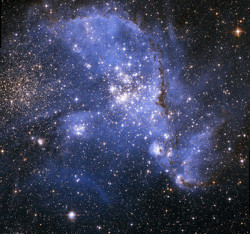In search of the most massive stars
Until recently, observational evidence suggested that the upper mass limit on stars was about 150 times that of our Sun. While it may be more than two times that according to new evidence, much is left to be learned about massive star formation and evolution as well as the still elusive stellar mass limit. On the other hand, massive stars with their tremendous gravitational pulls are important drivers of the evolution of galaxies. European researchers sought to extend the catalogue of the most massive stars in the local universe, namely in our Milky Way and nearby galaxies, including the Small Magellanic Cloud (SMC). Massive stars are rare, short-lived and usually hidden inside dense clusters shrouded in dust. With EU funding of the project 'The most massive stars in the local universe' (MOSTMASSIVESTARS), scientists discovered massive stars in eclipsing binary stars and measured fundamental parameters to provide constraints on their formation and evolution. Eclipsing binaries are two stars orbiting around the common centre of mass. The orbit plane is along the line of sight of an observer on Earth such that the one eclipses the other. Measurements of periodic changes in brightness allowed MOSTMASSIVESTARS researchers to discover over 100 massive eclipsing binaries and reliably calculate the mass, radius and density of stars in 6 massive eclipsing binaries. In addition, the variability of some 4 600 massive stars in the SMC, some of which are surrounded by gaseous disks, was studied. As a result of intense radiation, these massive stars are characterised by significant mass losses, causing visible brightness variations and lower metallicity (namely lower portions of elements heavier than helium). Armed with the high-resolution images from the Las Campanas Observatory in Chile, the MOSTMASSIVESTARS team discovered 20 new systems in the massive Danks clusters in our Galaxy. The data are expected to enable rigorous testing of atmosphere and wind models of massive stars as well as stellar evolution models. Modelling the atmospheres and evolution of massive stars has been a tremendous challenge for astronomers, because the stellar winds influence their evolution as well as their surroundings profoundly. The MOSTMASSIVESTARS project's findings could also provide a new window into their effects on the dynamics of their host galaxies.



